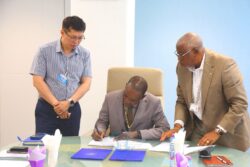The thrift business, known as the ‘foos industry’ or ‘obroni wawu’ in the local parlance, plays a significant role in Ghana’s economy. This industry primarily deals with second-hand clothing imported from Europe and North America. In this article, we will explore the world of Ghana’s foos industry through the eyes of the market women who are at the heart of this bustling trade.
Ghana’s Kantamanto Market, located in the capital city of Accra, stands as the largest second-hand clothing market in West Africa. This vibrant marketplace provides employment for approximately 35,000 traders and contributes millions of dollars to Ghana’s GDP annually. It serves as a central hub for the trading, buying and selling of second-hand garments from around the world.
However, behind the scenes of this thriving industry lie challenges that threaten the livelihoods of market women and the sustainability of the foos trade. The import duty hike, economic factors, and environmental concerns have cast a shadow over the once-booming market.
In the following sections, we will delve into the experiences, perspectives and conversations with market women who navigate these challenges daily. They will share their insights on the impact of import duty hikes, economic fluctuations, and the environmental implications of this industry. Together, we will explore potential solutions and envision the future of Ghana’s foos industry.
The thrift business provides affordable clothing options for many Ghanaians, especially those with limited resources (The term ‘thrift’ refers to the practice of being economical and frugal with one’s resources). It allows people to buy clothes at lower prices compared to new ones, making them accessible to a large portion of the population. This is especially important in a country where not everyone can afford brand-new clothes.
Moreover, the thrift business supports small-scale entrepreneurs and creates job opportunities. Many Ghanaians work as second-hand clothing dealers, selling these items in markets and local shops. It helps them earn a living and contribute to their families and communities.
So, the thrift business is not just about buying and selling used clothes; it’s a vital part of Ghana’s economy, promoting affordability, entrepreneurship and livelihoods for many people.
Challenges faced by second-hand clothing dealers
-
Import duty hike and its impact on livelihoods
You know, being a second-hand clothing dealer in Ghana is not without its challenges. One major hurdle they face is the recent increase in import duty, which has had a significant impact on their livelihoods. Just imagine, the import duty has been hiked up by a staggering 153 percent!
This sudden surge in import duty means that the costs of bringing second-hand clothing bales into the country have skyrocketed. For example, in the first quarter of 2022, it cost around GH¢15,000 as import duty on a 40-foot container. However, since the first quarter of this year, that amount has gone up by over 300 percent to GH¢38,000. Can you believe that?
As a result, it has caused the prices of second-hand clothing bales to increase as well. This, in turn, has led to a significant loss of income for many dealers. Reports suggest that as high as 70 percent of second-hand clothing dealers are now struggling to sustain their businesses due to the knock-on effect of these increased costs.
-
Economic factors exacerbating the situation
Unfortunately, it’s not just the import duty hike that’s affecting the second-hand clothing industry. Several economic factors are exacerbating the situation for these dealers.
Firstly, there’s the depreciation of the Ghanaian cedi, the country’s currency. When the cedi loses its value against other currencies, it makes it more expensive to import goods, including second-hand clothing. This puts an additional strain on the already burdened dealers.
Secondly, high inflation is also a major concern. When prices of goods and services rise rapidly, it erodes the purchasing power of consumers. As a result, people have less disposable income to spend on clothing, including second-hand items. This decrease in demand can greatly impact the sales and profitability of dealers.
Lastly, the harsh economic environment in Ghana, coupled with additional taxes imposed on businesses, adds to the challenges faced by second-hand clothing dealers. They have to navigate through a tough market, deal with increased operational costs, and find ways to stay afloat amid these economic pressures.
So, you can see that the import duty hike and these economic factors have created a difficult landscape for second-hand clothing dealers in Ghana. They are facing increased costs, dwindling profits, and a challenging business environment.
Quality and environmental concerns
-
The volume of used clothing imports and disposal issues
You won’t believe the staggering volume of used clothing that Ghana receives from the West every week. It’s estimated that around 15 million items of used clothing are sent to Ghana from industrialised countries. That’s a huge amount!
However, here’s the shocking part: approximately 40 percent of these imported clothing items end up being discarded due to their poor quality. It’s disheartening to think that a significant portion of these clothes, which were originally donated with good intentions, are not suitable for use and end up being wasted.
-
Impact on Ghana’s markets and environment
To get a better understanding of the impact, let’s take a closer look at Ghana’s Kantamanto Market. It serves as a hub for the sale and distribution of used clothing from the West. Many Ghanaians rely on this market for their clothing needs.
In recent times, the deliveries of second-hand clothing from the West have focused more on what we call ‘fast fashion’ items. These are clothes that are made quickly and cheaply; but unfortunately, they also wear out quickly. Some traders find it challenging to sift through these low-quality, short-lived garments.
The disposal of rejected and unusable clothing items poses significant environmental hazards. Can you imagine where all these discarded clothes end up? Many of them find their way to landfills, contributing to the growing waste problem. Moreover, when disposed of improperly, they can even end up in oceans and further harm the environment.
Ghana is facing both market and environmental challenges due to the influx of used clothing. The market is flooded with low-quality items, and the environment suffers from the disposal of vast amounts of unwanted garments. These issues call for sustainable solutions to tackle same and ensure a more responsible and eco-friendly approach to the thrift industry.
-
Promoting sustainable practices and solutions
To address these quality and environmental concerns, market women are actively seeking sustainable alternatives. One approach involves developing a system for tracing the lifecycle of second-hand clothing, ensuring better quality control, and reducing waste. By tracking the origins and condition of clothing items, market women can make informed decisions about which products to import and sell.
Non-governmental organisations (NGOs) are also playing a crucial role in advocating for responsible practices in the thrift industry. They provide guidance and recommendations to market women on sustainable sourcing, waste reduction, and promoting circular economy principles within the industry.
The future of the thrift industry in Ghana
-
Market trends and shifting consumer preferences
As we look ahead to the future of the thrift industry in Ghana, it’s essential to consider the evolving market trends and shifting consumer preferences. In recent years, there has been a noticeable change in how people approach fashion and clothing choices.
More and more consumers are becoming conscious of sustainability and ethical fashion practices. They are increasingly drawn to brands and businesses that prioritise environmental responsibility and promote fair trade. This shift in consumer mindset presents an opportunity for the thrift industry to adapt and align with these changing preferences.
-
Opportunities for innovation and diversification
To thrive in the future, the thrift industry in Ghana must seize opportunities for innovation and diversification. One potential avenue is to focus on curating high-quality and unique second-hand clothing items. By offering a selection of well-maintained, stylish pieces, dealers can cater for consumers who value both affordability and fashion.
Moreover, embracing digital platforms and e-commerce can expand the reach of the thrift industry. Online marketplaces provide a convenient way for consumers to access second-hand clothing and increase sales potential. It opens up new avenues for growth and allows dealers to tap into a broader customer base.
-
Potential strategies to overcome challenges and ensure sustainability
To overcome the challenges faced by the thrift industry and ensure its sustainability, several strategies can be considered. Collaboration between government agencies, industry stakeholders, and non-profit organisations can play a crucial role. They can work together to address issues such as import duty hikes, economic pressures and environmental concerns.
Developing and implementing regulations to ensure the quality of imported second-hand clothing can also boost consumer confidence. This can involve stricter quality control measures, standardised labelling and certification processes. By ensuring that the clothes imported meet certain standards, dealers can provide better value to customers.
Furthermore, promoting sustainable practices – such as recycling, upcycling and proper disposal methods – is vital. Encouraging the adoption of eco-friendly packaging and reducing waste in the supply chain can contribute to a more sustainable thrift industry.
Lastly, the future of the thrift industry in Ghana lies in adapting to market trends, embracing innovation, and implementing strategies for sustainability. By catering for shifting consumer preferences, exploring new opportunities and addressing challenges collectively, the industry can navigate the path to a more prosperous and responsible future.
Conversation with market women in the thrift – ‘Foos’ industry at Kantamanto, Accra Central
To gain a deeper understanding of the second-hand clothing industry in Ghana, let’s have a conversation with some market women who are actively involved in the business. These women have first-hand experience and insights to share.
Aunty Afua (Kantamanto market): I’ve been a second-hand clothing dealer for over a decade now. It’s been quite a journey in this industry. We work hard to provide affordable clothing options to our customers and support our families.
Madam Rose a.k.a Quality (Kantamanto): I’ve also been in this business for twenty-five years, and it has its ups and downs. We face various challenges, but we’re resilient and always find ways to adapt. This business has sustained my family over the years, especially my children through the university.
Discussion on the challenges they face and their perspectives on the future
Me: Could you share some of the challenges you encounter as market women in the foos industry?
Madam Rose: One of the biggest challenges we face is the increasing import duty. It has put a strain on our businesses, making it harder to make a profit. The rising costs of second-hand clothing bales have affected our ability to provide affordable options for our customers. I used to import dozens of bales but recently, I’m unable to.
Aisha (Kantamanto): And don’t forget the economic factors like cedi depreciation and high inflation. It’s becoming tougher for people to afford even second-hand clothes. Our customers’ purchasing power is decreasing, which directly impacts our sales. We drastically reduce the prices so they can afford it and save us from keeping bales that would become garbage later.
Me: With these challenges in mind, what are your thoughts on the future of the thrift industry?
Aunty Afua: Well, it’s certainly a challenging time, but I believe there’s hope. We need to adapt and find ways to cater for changing consumer preferences. People are becoming more conscious of sustainability, so we can focus on providing high-quality and unique second-hand clothing options.
Madam Rose: I agree. We can also explore online platforms to reach a wider customer base. Embracing technology and innovation can help us overcome some of the challenges we face. As for me, I’m a little educated so I try my best to sell some of my goods on Instagram and Facebook. My children also help with social media as well.
Abena (Kantamanto): The import duty hike has hit us hard. The increased costs have eaten into our profits, making it difficult to sustain our businesses. We used to provide affordable clothing options for our customers, but now we have to increase prices and that affects our sales.
Berima Joe (Kantamanto): The economic situation has been tough. The depreciation of the cedi and rising inflation have made it even more challenging for us. Our customers’ purchasing power has decreased, and they are becoming more selective in their purchases. We have to find ways to adapt and keep our businesses afloat.
Obroni (Kantamanto): The disposal issue is another concern. We receive a significant amount of clothing from the West; but unfortunately, a substantial portion of it is of poor quality. It’s disheartening to see so many items being discarded. We need solutions to ensure that we receive better quality clothing that can be sold to customers.
Insights into their strategies for adapting to changing circumstances
Me: How are you adapting to the changing circumstances and consumer preferences?
Madam Rose: Personally, I’ve started curating a collection of well-maintained and stylish second-hand clothing items. By offering unique pieces, I can cater for customers who value both affordability and fashion. As I said, I sell most of these on Instagram and Facebook, thanks to my children.
Lizzy: I’ve also started exploring online platforms and social media to showcase our products. It’s a great way to connect with customers who prefer the convenience of online shopping. Sometimes, my clients request ‘special selections’ brought to them in their homes or offices after work.
Berima Joe: To overcome the import duty hike, we have formed cooperative buying groups to share the costs. By pooling our resources, we can still import clothing at a reasonable cost and maintain competitive prices for our customers.
Obroni: We are exploring alternative income streams by diversifying our product offerings. Some of us have started selling locally made clothing alongside second-hand garments. This helps us cater for customers looking for unique and affordable options.
Cornie: We are also embracing sustainable practices. We encourage customers to repair and reuse their clothing, reducing waste. Additionally, we are exploring partnerships with NGOs and organisations that promote responsible practices in the thrift industry.
Conversations around potential solutions and collaboration
Me: What do you think can be done to address the challenges faced by the thrift industry?
Mama Mama: Hmm, it would be helpful if the government could reconsider the import duty hikes. It’s killing the business. We need support to keep our businesses viable and continue providing affordable clothing options.
Cornie: I also think there should be more collaboration between government agencies, industry stakeholders and non-profit organisations. By working together, we can find sustainable solutions and address environmental concerns related to discarded clothing. If you come here on a Sunday, somewhere dusk, you will see the waste we generate because the bales are mostly bad. There is no place to dispose of them. We pay the Zoomlion ‘guys’ to do the rest. On other days, we burn them or upcycle them.
Me: That’s a great point. Collaboration is key to ensuring the future sustainability of the thrift industry. Together, we can develop regulations, promote sustainable practices, and create a better environment for everyone involved.
Lizzy: We need the government’s support in addressing the import duty issue. Lowering the duty or providing tax incentives for the foos industry would be a significant relief for us. It would help us continue to provide affordable clothing options for Ghanaians.
Mama Mama: I like what Cornie said. Collaboration is key. We also need to work together as market women, sharing best practices and supporting one another. We can also collaborate with designers and local artisans to create unique products that blend new and second-hand materials.
Mauda: It’s important to engage in dialogue with international partners and organisations to find sustainable solutions, especially the Chinese. By addressing the quality of clothing sent to us and exploring initiatives to reduce waste and environmental impact, we can create a more sustainable and thriving thrift industry.
In this conversation with the market women, we gained valuable insights into their experiences, challenges and strategies for adapting to changing circumstances. Collaboration and innovative approaches will play a significant role in shaping the future of the thrift industry in Ghana. By addressing these challenges collectively, we can work toward a more sustainable and prosperous future.
Policy and sustainability measures
-
Efforts to develop sustainable solutions
In the quest for a sustainable thrift industry in Ghana, several initiatives and research efforts are underway to find innovative solutions.
Research on sustainable second-hand clothing tracers
Researchers are exploring the development of sustainable second-hand clothing tracers. These tracers aim to track the lifecycle of garments, ensuring transparency and accountability in the supply chain. By implementing such tracers, the industry can better manage the quality and origins of imported second-hand clothing, reducing waste and promoting responsible practices.
-
NGO initiatives and recommendations for responsible practices
Non-governmental organisations (NGOs) are actively involved in promoting sustainable practices within the thrift industry. They provide recommendations and guidelines to market women, importers and policy-makers on responsible practices, waste reduction and environmental protection. These initiatives create awareness and foster a sense of responsibility among stakeholders.
-
Policy considerations and potential solutions
To ensure the sustainability of the thrift industry, policy-makers and government agencies can play a pivotal role in implementing effective policies and regulations.
-
Government regulations to ensure quality and protection of the environment
Government regulations can be put in place to ensure the quality of imported second-hand clothing. This can include stricter quality control measures, standardised labelling and certification processes. By enforcing these regulations, the market women and consumers can have greater confidence in the products, ensuring value for money and reducing waste.
Furthermore, regulations can address environmental concerns related to the disposal of discarded clothing. The government can incentivise and encourage proper waste management practices, recycling initiatives and the use of eco-friendly packaging.
-
Collaboration with international partners to address disposal issues










